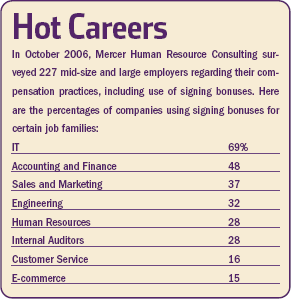 Signing bonuses have their place, but they must be structured to avoid encouraging high turnover in a local job sector.
Signing bonuses have their place, but they must be structured to avoid encouraging high turnover in a local job sector.
As unemployment numbers drop to levels not seen since the dot-com era, signing bonuses are again on the rise for people with IT and other skills in short supply.
“We are seeing sign-on bonuses become a lot more prevalent,” says Ravin Jesuthasan, managing principal in Towers Perrin’s Chicago office.
Fortunately, employees are not demanding the $24 million that quarterback Alex Smith banked for signing with the San Francisco 49ers as the top draft pick in 2005. But even by offering relatively low amounts, companies can attract the employees they need to build a winning team.
“Bonuses allow you to pay a premium to attract individuals without dramatically upsetting your salary scale,” says Steve Gross, senior consultant for Mercer Human Resource Consulting in Philadelphia.
Negotiating a Number
There is no hard-and-fast rule for determining when to offer a signing bonus or how much to pay. Companies implement them in a variety of ways.
“Securing acceptance from a candidate is like facilitating any other business transaction; it is a negotiation process,” says Layne Buckley, PHR, senior manager of U.S./Asia Pacific Latin America compensation and systems for headset manufacturer Plantronics Inc. in Santa Cruz, Calif. “In general, a signing bonus should be used to help secure acceptance from a candidate or to offset other forms of compensation.”
There are two primary factors to consider when deciding whether to offer a bonus and how much it should be. The first is supply and demand, which varies with general market conditions and specific skill sets, as well as individual proficiency.
“Sign-on bonuses became a big part of compensation in the late 1990s during the mad rush to Y2K,” says Jesuthasan. “There was a tremendous demand for IT folks who could address that need, and we saw sign-on bonuses go from a relatively nominal and infrequently used tool, outside of top management, to being directed at low-level employees in specific skill groups.”
In-demand skills vary, however, over time. At one point, the Y2K talent commanded bonuses as high as 100 percent of annual base salary. Those folks haven’t been much in demand the last seven years, while demand for people with other IT skills has fluctuated since then. Sales and executive positions also demand high bonuses for proven producers, and nurses currently command bonuses.
“Over the years, nursing shortages and gluts go back and forth,” says Gross. “Right now we are more in a shortage stage, but as more people go to school and the supply increases, that shortage will ease. But I don’t think we will see a glut again as the aging population will demand even more nurses.”
Jesuthasan also forecasts a large number of signing bonuses in certain accounting specialties as companies struggle to cope with the Sarbanes-Oxley Act. In addition, bonuses are becoming prevalent in engineering fields where a large percentage of workers are approaching retirement age.
“We are also seeing a fair bit in the energy sector, given the demographics of petroleum engineers,” he says. “A lot of dollars are being given to get employees to switch” companies.

Another key factor in determining the use of signing bonuses and their amounts is how much the person is leaving behind in order to make the switch. Even if you are offering a salary that is equal to what a person is currently making, that person may be taking a hit on their pension vesting, their 401(k) or other parts of their total compensation package, so these losses need to be taken into account.
“When you hire an executive during the year, they are leaving some of their bonus opportunities with a former employer,” says Gross. “If you hire someone six months into the year, they are only getting half their bonus, so some of the sign-on bonus is to make up for that.”
One other possible factor is the potential employee’s need to relocate. If the company has a policy against paying relocation fees to new hires, financial help can be included as part of a sign-on bonus.
Beyond crunching the hard numbers of the market and the benefits packages, there is also the human factor: What will it take to get someone to embrace the risky proposition of leaving their current, established position and trying something new?
“You need to offer some sort of risk premium—higher salary, better training, better career opportunities—and you can mitigate that risk by saying, ‘Here is something up front,’ ” says Gross. “In the United States, it is somewhere in the range of a 15 percent to 20 percent premium based on base salary.”
While that figure provides some sort of a benchmark to work with, the exact figures will vary with each individual.
“There is a negotiation [around] what am I leaving on the table, what are the odds of getting it, what is the new opportunity at this company, and what will it take to restore lost benefits,” Gross continues. “Then there is the matter of how much more [does the company] need to offer to attract a person.”
So, how much does all this come to?
“Unfortunately, there isn’t a simple rule of thumb that people can use,” says Jesuthasan, “but I have seen the numbers range from a month of salary to—in the worst extremes—a year of salary.”
Catch and Keep
Signing bonuses’ primary benefit is the opportunity to attract new talent without permanently inflating the salary structure.
Sign-on bonuses aren’t subject to cost-of-living increases, workers’ compensation, Social Security taxes, pension benefits, 401(k) contributions, and other expenses and benefits tied to base salaries. “When you are further up in the ranks, you are eligible for bonuses that you are not eligible for at lower ranks, and those are often computed as a percentage,” says David Foote, president of Foote Partners LLC in New Canaan, Conn.
But sign-on bonuses also have shortcomings. One is the internal friction and demand for salary increases that result when it is known that one employee’s total compensation package exceeds her peers’.
“It is a matter of supply and demand; I don’t control the market,” says Gross. “If I have to bring someone in at a higher rate, I have to do that, but over time I try to give people some degree of equity” by adjusting future pay.
The other major drawback is that as signing bonuses become prevalent in a particular job sector, they can encourage high turnover, as has occurred among nurses in some cities.
“Sign-on bonuses are there to get people to move and can create a morale problem,” says Jesuthasan. “It can become a merry-go-round.”
The first way to avoid this is to properly structure the bonus agreement so that the person repays the bonus if they leave before a certain time period.
“If the job is largely project-based, you would see something tied to the timeline of the project,” says Jesuthasan. “If a regular, full-time employee, we would see it cover a year or two. It is all based on the person staying, not on the person’s performance.”
The contract should state the conditions for any repayment of the bonus. Typically, an employee would be responsible for repaying the bonus on a sliding scale if he or she left voluntarily or were terminated for cause. But the employee would keep the bonus in the event of a layoff or termination of a project.
Buckley says that most employees have no problem agreeing to repay the bonus if they leave early. When they don’t agree, watch out.
“The candidate’s response to a payback period may be revealing in itself,” he says. “If the candidate is not comfortable with repaying a signing bonus if they leave voluntarily in one year or less, this may raise other concerns regarding the hire.”
Putting these provisions into the contract should help prevent the premature loss of talent, but one shouldn’t rely on the threat of having to pay back the bonus as the only part of the retention strategy. Another way to keep these employees is through the appeal of the overall employment opportunity.
“The way you mitigate against people switching in the first place is to have a total rewards proposition in the organization that is far more compelling than the competition and creates some real hooks into the talent,” says Jesuthasan.
He says that the career trajectory, development opportunities and skill acquisition can be more important than just throwing money at the staff. “All those intangibles, what we call the relational rewards, we have found to be more effective in hanging onto folks than just money,” he says. “You have to be competitive on salaries, but the relational rewards push things over the edge in terms of retaining someone.”
Staying FlexibleAll the details should be clearly laid out in the contract, and should be reviewed for compliance with company policy and applicable laws. For example, signing bonuses paid to a nonexempt employee will be considered part of that person’s base pay for computing overtime pay under Section 7(e) of the Fair Labor Standards Act. This can add substantially to costs when the person is putting in large amounts of overtime. In addition, since the hourly value of the bonus is divided across both the regular and the overtime hours, it is impossible to accurately determine the correct amount of overtime pay until the end of the period covered by the sign-on bonus. This requires going back and calculating any additional overtime pay due at the end of the period covered by the bonus.
“Look how the practice conforms to the policy,” says Gross. “If something doesn’t conform to the policy, I’d want to document it so it is defensible if someone challenges it, or I’d want to change my practice.”
Buckley, however, cautions against getting so rigid in one’s policies that it inhibits the negotiating process.
“I would recommend that employers be careful about setting strict policies,” he says. “One of the greatest values of signing bonuses is that they add flexibility to a salary negotiation. By having strict guidelines, much of the flexibility is lost.”
Foote says that using signing bonuses to bring someone on board gives the company another year to see how the person performs, at which time it can negotiate a longer-term agreement. If the tech skills are still hot at that time, a skills or performance bonus can be implemented as a retention strategy.
“Sometime in the next year, you can work it out,” he says. “You want to keep the base pay constant, but if they are performing as expected, you can replace the sign-on bonus with a performance bonus. It gives you some time to think about it, and gives more flexibility.”
By being free to use signing bonuses as one part of the give-and-take negotiating process to tailor a package that meets both the employee’s and the company’s needs, HR can do a better job of hiring and retaining needed staff.
“Signing bonuses offer a great deal of flexibility in the negotiation process,” says Buckley. “From a tactical perspective, flexibility in negotiation should make HR more successful in hiring candidates and make the candidates feel as if there was collaboration during the negotiation process.”
Drew Robb is a Los Angeles-based freelance writer who specializes in business, technology and engineering.Advertisement
An organization run by AI is not a futuristic concept. Such technology is already a part of many workplaces and will continue to shape the labor market and HR. Here's how employers and employees can successfully manage generative AI and other AI-powered systems.
Advertisement


